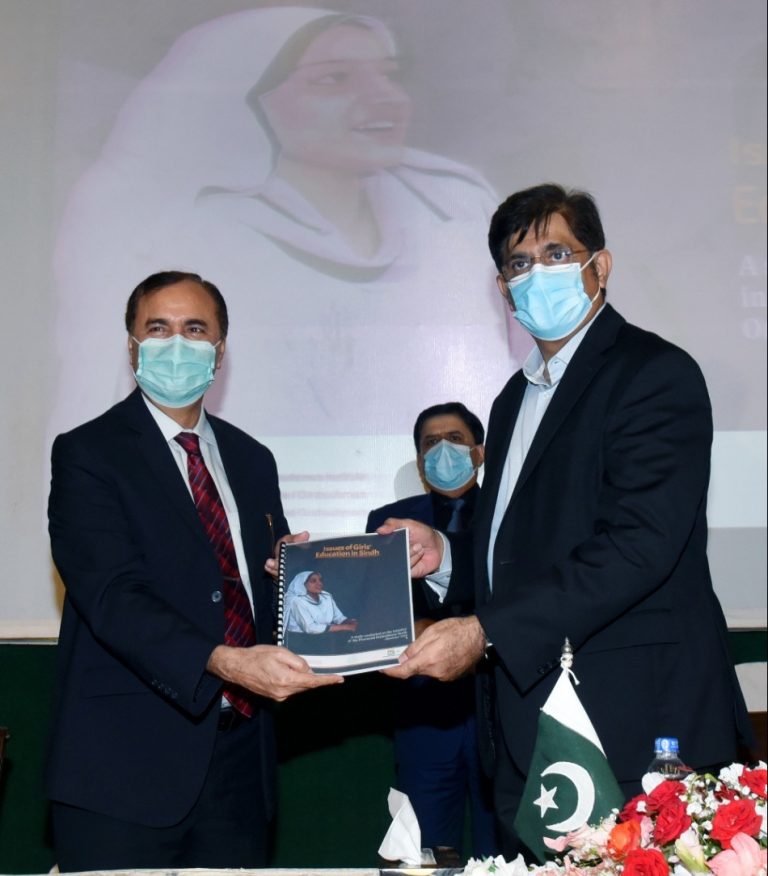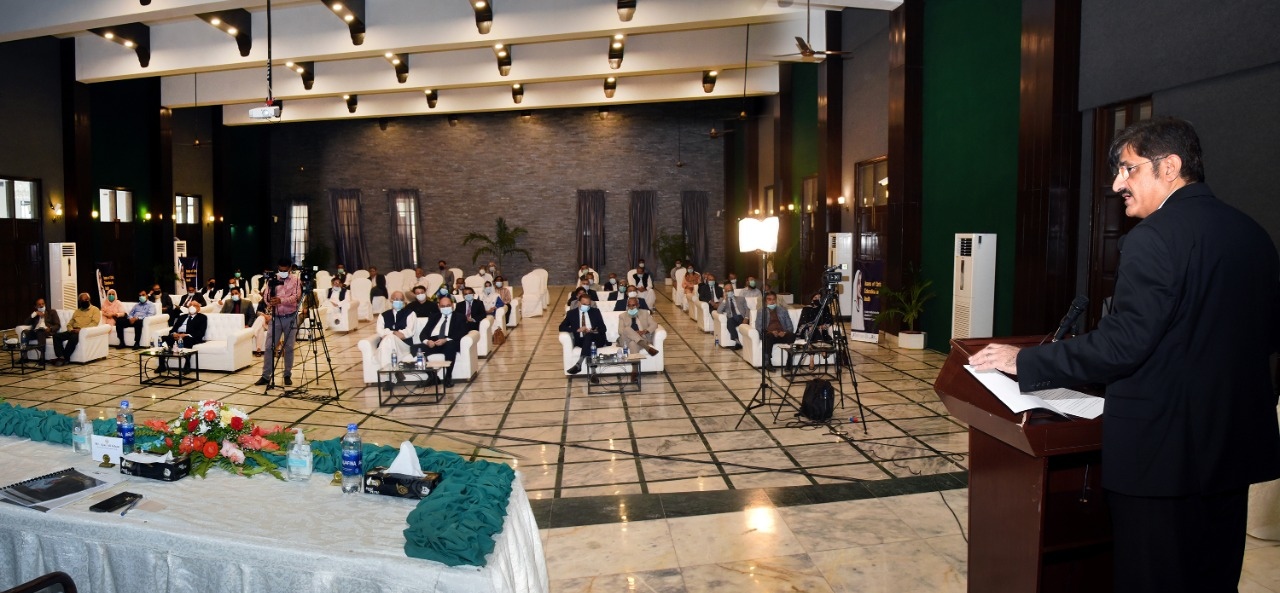
The study carried out by Sindh Education Foundation on the initiative of provincial Ombudsman has been is funded by International Ombudsman Institute under the Regional Subsidy Program.
Karachi
A recent study carried out in Sindh suggests that the Socio-Cultural, Political and Religious norms of the society have a negative impact on women’s position and their identity in the society.
“The structure of the society is patriarchal. A narrow-minded approach, rigid norms and traditional practices coupled with patriarchal hegemony have significantly contributed to depriving girls from acquiring education,” says the study carried out by Sindh Education Foundation on the initiative of provincial Ombudsman. The report was launched on Thursday at a ceremony held at Chief Minister’s House Karachi.
To investigate the issues relating to girls’ education particularly in Sindh, the Provincial Ombudsman had awarded consultancy to Sindh Education Foundation (SEF), to carry out a research study on the subject. The study is funded by International Ombudsman Institute under Regional Subsidy Program. The key objectives of the study are to identify the dynamics of socio-cultural, economic, political and religious and supply side factors, hampering the gains of girls’ education in Sindh.
The scope of the research was mainly desk research consisting of secondary data from local and global literature. However, primary data from in-depth semi-structured interviews with key stakeholders in Sindh has also been gathered and analyzed. The report discusses key findings on the status of girls’ education in the country in general and in Sindh in particular.
Findings from Desk Research
The overall number of Out of School Children (OOSC) was reduced in 2018-2019. However, the majority of the school-going children are still not able to have access to schools and the majority of these children are girls. Dropout of school children in general and the girls in particular, is a chronic issue; particularly in the rural areas. When children transit from primary to secondary schools, the rate of drop out gets higher.
One of the key factors for low levels of girls in education is dearth of Middle, Secondary and Higher Secondary Schools in Sindh. Generally, parents are reluctant to send their daughters to long distance schools. Missing school facilities including boundary walls, shelters, functioning washrooms, drinking water, minor repairs and other necessary items also lead to dropout of girls from schools.
Female teachers in girl schools are essential as cultural norms are against the mixed gendered/single sex schools (boy schools). This becomes more challenging when girls reach puberty or pre-pubescent age which further limits their mobility. Poverty restricts poor and low-income families to invest in their children’s education. Therefore, it keeps many girls away from school. Child labor becomes a crucial source of income for poor families in Sindh and parents send their girls to work as paid or unpaid workers or help families in agriculture activities to improve their family income.
Findings from Primary Data
Ombudsman Aijaz Ali Shah said that the first and foremost issue in girls education is limited accessibility to schools. He added that girls in government schools drop out drastically after completing primary education as the middle or high schools were not available in the vicinity.
According to the Ombudsman drop out starts from grade 4 and onwards, when girls grow up, especially, when there is no female teacher in the school. Gradual shift has been observed in narrow minded attitudes, old traditions, and culture towards girls’ education in Sindh, yet gender gap persists in the education system.
Gender imbalance is a reflection of the social fabric of a society. The difference in roles and responsibilities between boys and girls starts from their families, schools and cultural background. Low-income families do not afford the cost of education. The poor quality of education in Sindh widens the gap between girls’ enrollment and retention rate in primary and secondary schools.
In High/ Secondary schools (where girls of adolescent age studying), lack of functional, private and secure washrooms and the boundary wall are major reasons which hinder girls from attending schools. It was also found that implementation of Policies and Plans is a tough and demanding task.
Recommendations
The study report recommends reviewing existing policies from a gender perspective and strengthening monitoring mechanisms. It requires collaborative efforts of all key stakeholders, including the education department, Sindh Education Foundation, Provincial Ombudsman and local administrative offices.
The report suggests organizing community awareness/ campaigns, workshops should be held at local level on a regular basis. Activation of School Management Committee (SMCs) and Female leaders may lead the SMCs. Cross cutting themes on gender should be part of every professional development of Teachers, the report suggests. Gender Units should be established both at the education department and SEF.
Priority should be given to up-gradation and consolidation of primary schools into elementary/secondary schools and provision of adequate facilities and competent female teachers.
For increasing girls’ enrollment at Post Primary level, the study recommended that Government Boys High Schools (GBHS) and Government Boys Higher Secondary Schools may be renamed as Government High Schools (GHS) and Government Higher Secondary Schools (GHHS) respectively.
 Addressing the ceremony, Chief Minister Murad Ali Shah said the socio-economic, cultural and religious factors obstruct the girls’ education and deprive them of opportunities to learn and develop into agents of change for our society.
Addressing the ceremony, Chief Minister Murad Ali Shah said the socio-economic, cultural and religious factors obstruct the girls’ education and deprive them of opportunities to learn and develop into agents of change for our society.
“It is only through education that girls are nourished and groomed as responsible citizens, capable of playing a positive and creative role in social development”.
CM said that he assigned top priority to girls’ education and planned to allocate greater resources for the purpose. “Obstructions to girls education – traditional administrative and financial would be removed and a conducive environment for promoting girls education would be ensured. “It is in our national interest that this important and sensitive issue is addressed on an urgent basis with consistency and resolve to muster all the essential components for promoting girl’s education,” he said.
Shah said that it was an unfortunate that despite efforts of the government the girl’s education has been lagging behind. “The multiple causes for this situation have been aptly highlighted in the study paper,” he said and added girls must have their right to education as enshrined in the constitution and laws; otherwise, we would remain trapped in ignorance and poverty.
CM said that he has gone through the report and read its recommendations. He advised the education department to make efforts to put the recommendation into action.
Murad Ali Shah directed the local administrations at all levels- Divisional, District, Sub-Division and Taluka to devote time and attention to ensure proper functioning of girls schools in their areas. He directed the chief secretary to incorporate the component of smooth functioning of girls’ schools in the performance evaluation of local officers.
Supporting the idea of School Management committee (SMCs) should be headed by Mothers, the chief minister directed the Education Department to bring necessary changes in the rules to make it mandatory for the girls’ schools.
CM said that BISP has been one of the great success stories of the Peoples Party government acknowledged by international agencies. He added that in order to incentivize girl’s education conditional the Cash Transfers (CCT) system under BISP to be linked with the girl students’ enrollment in schools. “The Education Department should initiate necessary action in this regard,” he said and added a similar system to reward better performing schools on gender parity basis be introduced to create an atmosphere of healthy competition. (PR)
_____________________